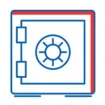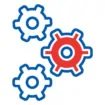Organizations that have embraced Lean have found it possible to achieve impressive improvements through the reduction of non-value-added steps and elimination of waste everywhere they apply the methodologies. This is especially true when Lean Warehouse Management practices are instituted. The payoff in greater efficiencies, improved safety, and higher productivity are immediate and long lasting. You might be asking yourself, why is Lean so effective in the warehouse and how can I hit the ground running?
As we saw earlier in our Why Inventory Management is Central to Lean article, having managers perform Lean analysis of a department or a specific area of operations can expose the root causes of inefficiencies and help identify the true sources of the seven wastes. This is equally true in how the warehouse is configured, operated, and maintained.
To understand Lean warehouse management it’s helpful to boil it down to its fundamental methodologies and objectives. The goal is simple: to create a system capable of optimizing warehouse operations through the reduction of waste and by improving efficiency. The results can be transformational: Streamlining the flow of materials and products through the warehouse to reduce and eliminate waste. In turn, these gains have a positive impact on quality, delivery times, sourcing of materials, more efficient use of equipment, better worker safety and prevention of loss or damage.
The practices for attaining these results are largely based on the 5S five-step methodology. Each of the 5S components represent Japanese words which describe the processes for optimizing the organization of a specific workplace, in this case, the warehouse.
Seiri: (Sort) The process begins by removing everything from the workplace that is not necessary to perform the job, such as tools, materials, debris, and objects being incorrectly stored.
Seiton: (Straighten, Set in Order) Next, arrange sorted items logically, making them easy to find and use. Floor tape, shelving, caged areas, and other approaches are typically used to enforce order as a routine to be followed.
Seiso: (Shine, Sweep) Following a thorough top-to-bottom cleaning of the workplace, all equipment is brought to like-new condition and tools are organized as a commitment to keep the workspace exceptionally clean.
Seiketsu: (Standardize) By creating standardized work procedures; checklists, assembly lines, labeling, regimented storage, etc. provides further opportunities for enhancing productivity, safety, and reducing non-value steps.
Shitsuke: (Sustain) Once the first four steps are accomplished, the long-term success of the effort is assured by maintaining the processes now in place, performing regular maintenance on equipment, and continuing the organizational standards for tools, equipment, and materials.
In some applications of 5S additional steps are used such as in 6S which includes Safety or Security or 7S which uses Spirit and Safety.
The 5S Wheel

(Courtesy 5S Today)
Will it work for me?
While the objectives of Lean warehouse management are obvious and the steps to arrive at this higher level of operations are obvious, challenges can creep up along the way. To reap the ongoing benefits of Lean Warehouse Management it takes discipline and, as with the use of all Lean and Six Sigma, getting everyone on the same page.
The key to 5S is consistency. That begins with continuing the daily practice of maintaining workspaces and equipment. All while ensuring the organizational processes are understood and adhered to, even when employees are “in a rush” or “there wasn’t time” to keep order.
Without Lean practices in place, work processes are often undocumented and communicated by word-of-mouth. This can result in individuals interpreting a process to suit their own work, habits and inconsistency which can undermine the entire purpose of 5S. Each worker has their own way of doing things which may not be efficient or cost-effective. Old habits, as they say, die hard.
To ensure the 5S principles stay on track, systems such as MRP or ERP platforms should be in place. Software which serves as an integrated business management solution with Lean principles “baked in” are the ideal solution to gain support for these changes at all levels of the organization, enforce the 5S methodologies once in place, and prevent improvements from being lost over time.
Other functions you should expect from an ERP/MRP warehouse management system include:
- Item master data to manage inventory by warehouse
- Visibility of in-stock, committed, minimum stock, and maximum stock
- Alerts to flag too little or too much inventory on hand
- Inventory audit reports with metrics such as quantity of an item by warehouse and how it is reflected in the general ledger
- Inventory audits and downtime reports for better items on hand control
- Tools and materials location and availability
If you’re ready to find out more about 5S and Lean in general, connect with one of our specialists. During the discussion we’ll explain how our customized systems provide for multiple warehouses on the same platform, each with a unique location and tax codes, ship-to addresses, and other functions pre-set yet easily modified to save time and increase productivity.





















